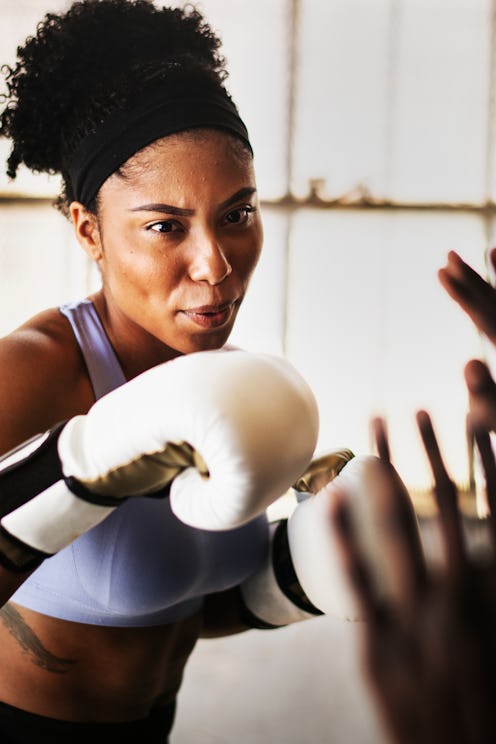Fitness
All The Muscles You Work In A Boxing Workout
Throwing jabs and crosses does a whole lot more than you might think.

Shutterstock
Whether you box in a group fitness class or throw hooks and jabs one-on-one with a trainer, boxing is guaranteed to work your muscles, make you sweat, and help you release pent-up energy. But what muscles does boxing work, exactly?
Shutterstock
Triceps
The triceps are the primary muscles that fire when you throw a punch or drive your glove into a heavy bag or your trainer’s mitts, says Gwen Dannenbaum, a trainer and director at KickHouse. You’ll feel it all through the back of your arms.
Shutterstock
Biceps
The biceps also light up during hooks and uppercuts. “They bring the power from your arm and also assist in the rapid retraction of your arm after you’ve thrown a punch,” Dannenbaum says.
Shutterstock
Forearms
As you punch, your forearm muscles work to straighten your hand and stabilize your wrist, Dannenbaum tells Bustle. Strong forearms also help protect your joints at the moment of impact.
Whether you do jabs, hooks, or uppercuts, your arms are guaranteed a good workout.
RyanJLane/E+/Getty Images
Deltoids
You’ll definitely feel the burn in your shoulders, too. Not only do you hold your fists up the whole time to guard your face, but you also power through your shoulders whenever you extend into uppercuts or pull back after jabs, Dannenbaum says.
Shutterstock
Quads
“Most people assume boxing mostly works your arms, but actually your legs and core are what fuel your punches,” says Lo Santos, a head coach at Title Boxing Club. The quads and hamstrings, in particular, drive your punches and move you around the bag or ring.
eyesfoto/E+/Getty Images
Hips
Your hips get in on the action as well. They connect your legs to your core to keep you balanced and help generate power through each swing, Santos says. Strong hips also help you quickly snap back to your boxer’s stance before steadying yourself to throw another punch.
Shutterstock
Obliques
The obliques get a good workout whenever you “slip” to duck or dodge a punch and when you twist to throw your own, Santos says. Boxing is all about winding up and rotating through the core so you can put your whole body weight behind each swing.
Nikola Stojadinovic/E+/Getty Images
Abs
“A strong core is one of the hallmarks of a boxer,” adds FightCamp trainer Aaron Swenson. “It allows you to throw more powerful punches.” Along with the obliques, he says you’ll also work your rectus abdominis and transverse abdominals when you box.